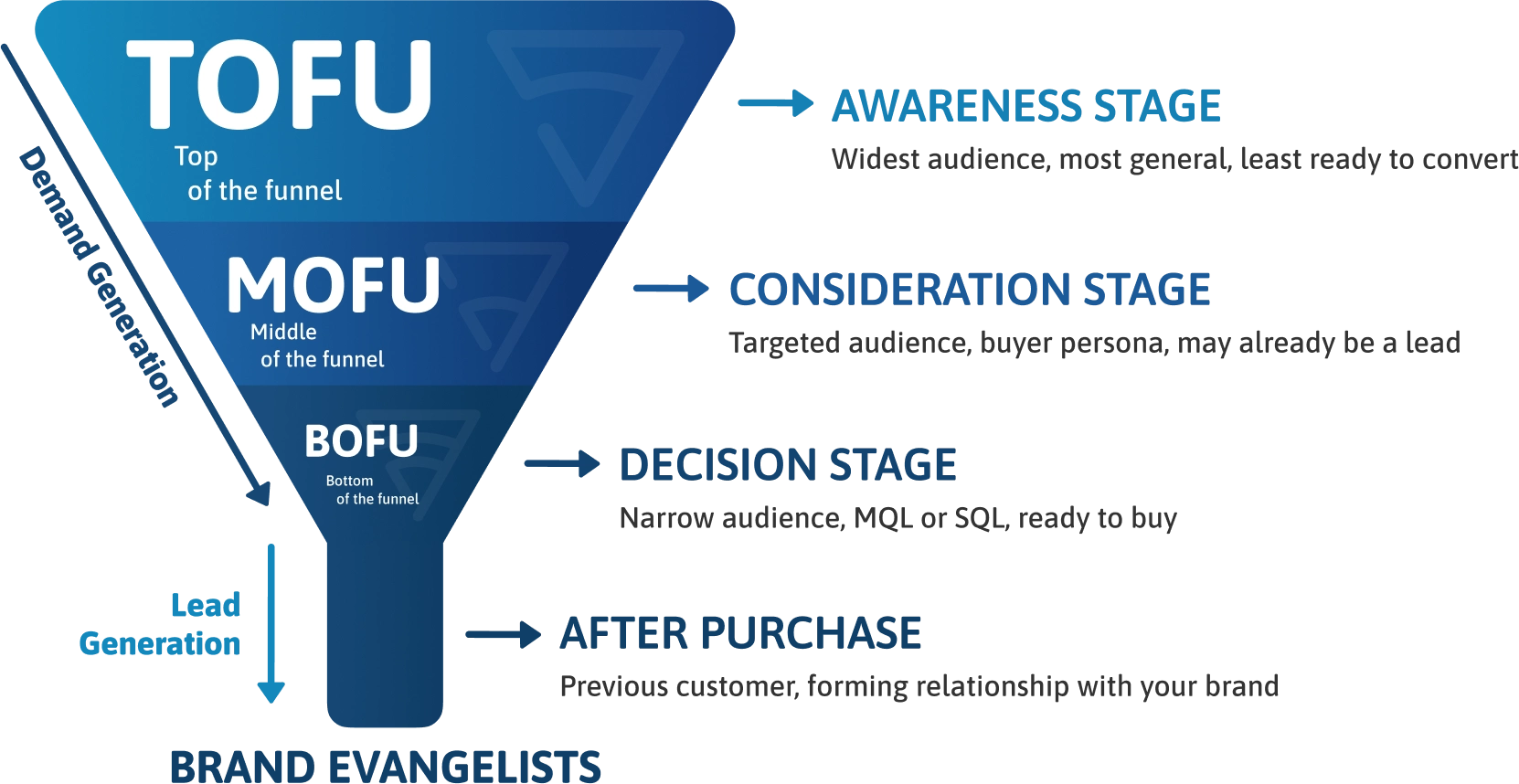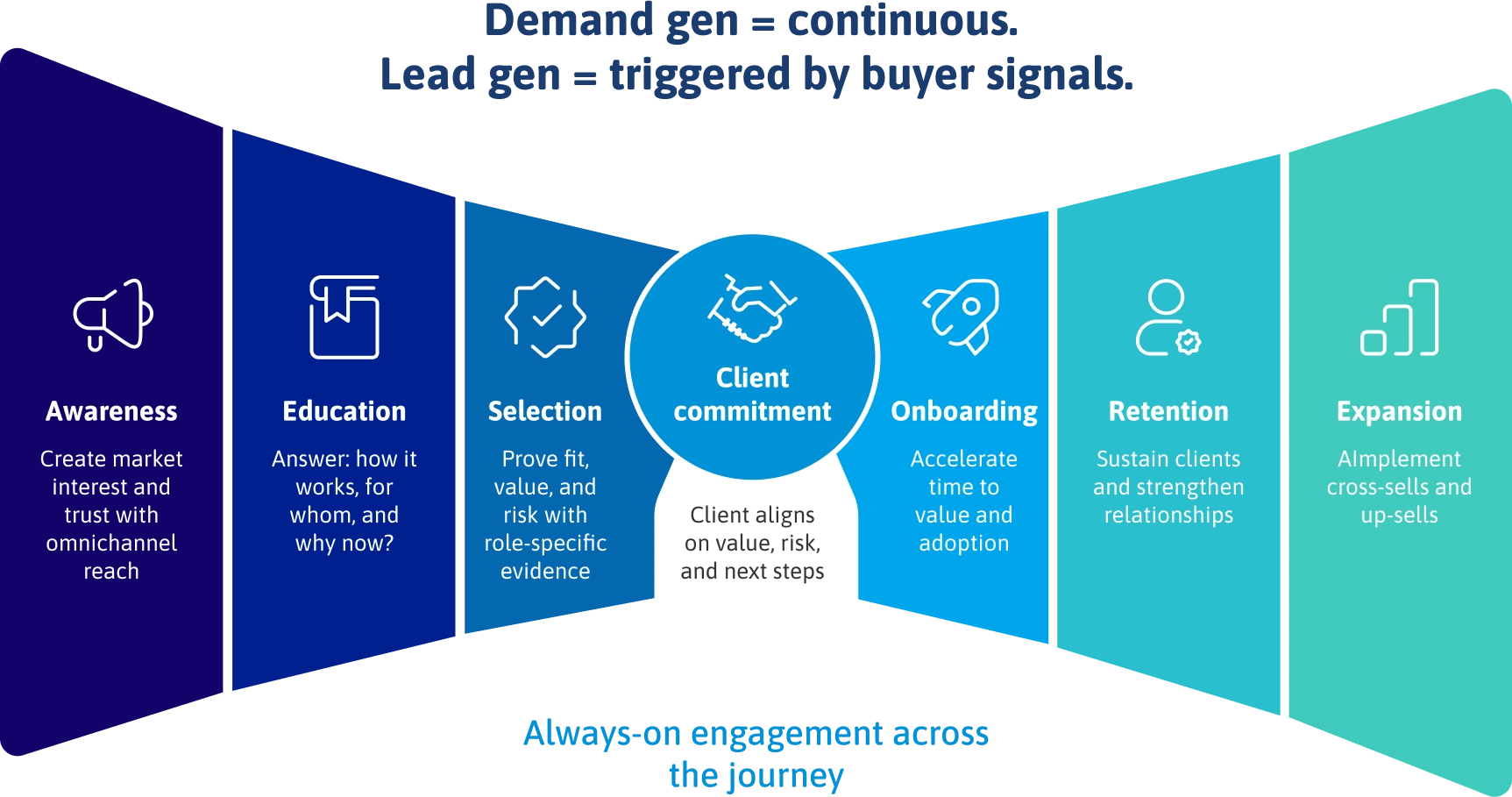What is Demand Generation? Demand Gen Vs Lead Gen
10 min

Executive summary:
Modern B2B growth requires creating demand, building trust, and converting intent into opportunities. Demand generation establishes awareness and nurtures intent across the buyer journey, while lead generation captures that intent to fuel sales. Modern organizations must integrate both to drive pipeline quality, accelerate deal velocity, and achieve long-term revenue growth.

Learn how demand generation and lead generation combine to form a continuous growth engine for modern B2B organizations.
What is B2B demand generation?
At its core, B2B demand generation is the strategic process of guiding prospective buyers through every stage of the buyer’s journey, from initial awareness, through consideration, to final decision. This is achieved by creating and sustaining interest in your brand and solutions.
Demand generation (also referred to as demand gen) focuses on building intent and trust over time by leveraging precise audience targeting and omnichannel engagement to connect with buying groups where they are most active.
Effective demand generation incorporates a range of strategies such as account based experience (ABX) platforms, intent-based advertising, and content designed to reach buyers even in the dark funnel—the untracked research activity buyers conduct before engaging with vendors.
By delivering consistent, valuable resources across all buyer touchpoints, demand generation ensures brands remain top of mind throughout the entirety of a buyer’s journey.
What is B2B lead generation?
B2B lead generation (commonly referred to as lead gen) is the process of capturing the contact information of potential clients who have already signaled interest or intent. This exercise is designed to enable follow-up and targeted outreach.
While demand generation builds awareness and nurtures relationships over time, lead generation focuses on converting interest into opportunities that sales teams can pursue.
Therefore, lead generation is the outcome of successful demand generation.
Modern lead generation combines tactics such as gated content, webinars, and event sign-ups with tools such as form enrichment, conversational chatbots, and strategic CTAs. The goal is to collect actionable data, such as names, business emails, job titles, and company details, that qualify the individual or buying group as a marketing qualified lead (MQL) or, in more intent-driven models, as a higher value sales qualified lead (SQL).
Considering current buyer journey habits, traditional form fills compete with buyers’ preferences for self-service, anonymous research, and on-demand content.
As a result, successful lead generation must adapt by offering frictionless capture methods, personalization based on behavioral signals, and strategic follow-up that aligns with where the buyer is in their decision making process.
What are the key differences between demand gen and lead gen?
Category
Demand generation
Lead generation
Objective
Build intent, awareness, and trust over the full buyer journey
Capture contact details from prospects who have shown interest
Buyer stage
Awareness, consideration, decision
Mid to late journey, once awareness or intent is established
Approach
Building long-term relationships with buying groups
Immediate capture of identifiable leads for follow-ups
Key tactics
ABX programs, intent based advertising, dark funnel content, thought leadership, targeted display, events
Gated content, webinars, event sign-ups, conversational chatbots, CTAs
Primary channels
Owned content hubs, industry publications, social amplification, targeted ads, events, peer communities
Landing pages, lead forms, live chat, event registrations, inbound calls
KPIs
Brand lift, engagement rates, account coverage, pipeline influence, buying group progression
Number of MQLs/SQLs, form completions, conversion rate to opportunity
Value focus
Quality and relevance over volume
Efficiency and volume of lead capture
Why should organizations invest in demand generation?
For B2B organizations, effective demand generation delivers a greater number of relevant prospective clients, accelerates sales cycles, and boosts average deal sizes.
Indeed, 68% of B2B marketers agree that demand generation delivers higher-quality prospects than traditional methods (Marketo, 2023).
B2B buying has transformed, therefore, so must the way organizations attract and engage potential clients. As it stands, 70% or more of the buyer’s journey occurs before a prospect ever speaks to a sales representative (6sense, 2024). This means that winning brands are those that can create awareness, build trust, and nurture intent well before direct sales conversations begin.
Demand generation delivers measurable ROI by aligning marketing and sales, feeding high-quality opportunities into the funnel, and sustaining engagement long after the first deal closes.
Demand generation vs. lead generation across the buyer’s journey

Lead Generation
Lead generation is the process of capturing the contact information of potential clients, typically through a variety of marketing strategies and channels tailored to specific audiences.
Demand Generation
Demand generation is the process of guiding prospects along their buyer’s journey with a brand and its offers, from completely unaware to becoming a qualified lead, and finally, a client.
For a deeper understanding, here are 7 reasons why organizations should invest in a modern demand generation strategy.
1. Demand generation builds brand trust
B2B buyers are more discerning than ever, consistently ranking trust as a critical factor in vendor selection. Multiple industry studies highlight this shift, with Edelman’s B2B Thought Leadership Impact Report (2024) underscoring that the majority of buyers place trust at the center of their decision making process.
Demand generation builds that trust by consistently delivering value through thought leadership, expert insights, targeted industry content, and personalized experiences across the channels buyers already use. This positions your brand as a credible partner, not just another vendor.
2. Demand generation powers full funnel marketing
The best demand generation programs connect early stage awareness with late stage conversion by aligning marketing, sales, and customer success teams around shared goals.
By integrating tactics such as account based experience platforms, intent based advertising, and dark funnel engagement, businesses can ensure prospects experience a seamless journey, regardless of when or where they choose to engage.
3. Demand generation aligns with modern buying behavior
Modern buyers move fluidly between online and offline touchpoints, engaging with multiple channels before making a decision. In fact, 73% of buyers expect to start their research on one channel and continue on another without repeating steps (Zendesk CX Trends report, 2023).
The average purchase cycle now is also over eleven months (6sense, 2024). This shift places greater emphasis on building trust, awareness, and intent well before a prospect enters your pipeline.
Demand generation enables this omnichannel continuity, ensuring messaging, offers, and experiences stay consistent and relevant throughout the longer journey.
4. Demand generation drives higher revenue, ROI, and prospect quality
While the primary aim of demand generation is to create interest and intent, its byproduct is a steady stream of more qualified prospects.
By leveraging firmographic, technographic, and behavioral data, marketing teams can score and prioritize accounts before handing them off to sales. This ensures a higher conversion potential.
68% of B2B marketers credit demand generation with delivering higher quality leads than traditional acquisition methods (Marketo, 2023). These leads are better informed, more engaged, and more likely to progress through the pipeline efficiently, which improves win rates and reduces wasted sales effort.
By focusing on quality prospects over quantity and nurturing high-intent accounts, demand generation reduces wasted spend on low-fit prospects and accelerates time to revenue.
26% of enterprise organizations across all industry segments now invest over 70% of their marketing budgets on demand generation (Voice of the Marketer, 2025), underlining its essential role in converting high-value opportunities.
Demand generation also compounds in value over time. It not only improves short-term pipeline conversion rates but also drives higher customer lifetime value (CLV) through stronger retention, larger average contract values (ACVs), and increased cross-sell and upsell success.
5. Demand generation increases brand awareness and recognition
Effective demand generation keeps your brand present across the channels and formats that your audience already uses. From thought leadership and content hubs to events, targeted display, and peer communities, demand generation ensures a strong omnichannel presence.
This consistent visibility builds brand preference and recall, lowering customer acquisition costs (CAC) and increasing inbound demand.
In fact, 81% of marketers believe demand generation is critical for brand awareness (HubSpot, 2022). Over time, this visibility compounds, creating a brand that buyers turn to first when needs arise. It is all about establishing a long-term asset that drives sustainable growth.
6. Demand generation builds buyer trust and strengthens buying group relationships
B2B demand generation plays a crucial role in cultivating and nurturing relationships with potential clients by creating awareness, interest, and engagement.
By tailoring messaging to address the specific needs and pain points of target audiences, organizations can establish themselves as problem-solvers and build trust with potential clients.
This is particularly relevant today, as modern B2B decisions often involve four to ten stakeholders (Voice of the Buyer, 2025). Demand generation nurtures all members of the buying group with relevant, personalized content that addresses role-specific pain points.
This multi-threaded approach builds trust, positions your company as a strategic partner, and increases the likelihood of consensus.
7. Demand generation promotes data-centricity and improves targeting
Data-driven demand generation strategies continuously improve targeting precision. By capturing intent signals and engagement patterns, marketers can dynamically segment audiences, adapt messaging, and select the right channels for maximum impact.
This can be achieved through:
This adaptive approach ensures demand generation stays relevant in fast-changing markets. In fact, more than 55% of organizations are investing in marketing operations to enhance efficiency and scalability, reflecting a growing recognition of marketing’s critical role in driving business growth and market agility (Demand Generation Benchmark Survey, 2025).
B2B demand gen plays a pivotal role in enhancing adaptability and agility within a business ecosystem. By fielding iterative demand generation strategies and making the most of data insights, businesses can develop a keen understanding of client preferences and better anticipate their needs.
How do demand generation and lead generation work together?
When properly aligned, demand generation and lead generation form a continuous growth engine that supports the entire Bow-Tie Funnel (depicted below), from first touch to post-sale expansion. This flow covers:

4-step guide to B2B demand generation
Below we have provided a 4-step guide to help businesses navigate the intricacies of B2B demand generation, offering strategic insights and actionable steps to fuel client interest and drive conversions.
Step 1: Data-driven targeting and ABM
Precision targeting in demand generation starts with a data-first approach. This involves integrating insights from multiple sources to engage the right accounts, buying groups, and decision makers at exactly the right time.
This is the foundation of modern ABM and ABX, where data is used to define audiences, as well as to anticipate their needs and deliver hyper-relevant interactions.
Account based marketing (ABM) can significantly increase revenue growth. 60% of companies see a minimum 10% increase in revenue in the first year of implementing a new ABM program (Demand Metric).
The difference:
When executed well, data-driven targeting improves resource allocation, prioritizes high-value opportunities, and significantly boosts conversion rates.
Effective buyer personas are dynamic profiles enriched with:
When collecting and using first-party data, always ensure compliance with GDPR, CCPA, and POPIA.
Step 2: Nurturing and content marketing
Extended B2B cycles demand always-on lead nurturing, not one-off campaigns. Buyers spend most of their journey engaging with content before sales, making consistent, personalized experiences essential to build trust and shape decisions.
To make the most out of content marketing, implement these lifecycle nurturing strategies across the funnel:
Delivering personalized content to meet buyer needs
Leveraging intent signals, behavioral data, and role-based insights helps you deliver timely, relevant content. Examples of this include dynamic nurture emails, role-specific ads, and retargeting aligned to the journey stage.
Content remains the engine of demand generation, however, content marketing is less about producing a high volume and more about strategic alignment with buyer needs and funnel stages.
Some of the most high-performing content types to explore are:
SEO is an essential element of B2B demand generation, requiring ongoing evaluation and optimization.
Strong keyword research and on-site optimization align your content with buyer intent, driving sustained visibility and traffic. High-ranking assets on SERPs generate long-term awareness and demand.
Answer Engine Optimization (AEO)
As AI reshapes search, optimizing for AEO is important for increased visibility. Beyond rankings, it builds early credibility by positioning your brand as a trusted resource.
Many best practices for AEO are similar to on-page SEO, such as:
Providing your audience with a free online tool is an excellent way to provide value and drive demand generation. The more useful the tool, the more likely it will be used and shared with others, extending your reach with your target audience.
Step 3: Omnichannel marketing
Omnichannel marketing delivers connected experiences across every device and stage, ensuring each touchpoint feels consistent, personalized, and relevant. B2B buying groups now interact with vendors across an average of 187 touchpoints per team per vendor (6sense, 2024), making seamless engagement essential.
A strong omnichannel strategy embraces this and ensures every touchpoint feels consistent, personalized, and contextually relevant.
Still one of the highest-converting channels, email succeeds when implemented strategically. Tactics like progressive profiling, behavioral triggers, and continuous optimization are important for engaging modern buyers.
Events are powerful multi-stage funnel accelerators. Some of the best event types by funnel stage include:
Repurposing event content through short clips, nurture workflows, and tailored follow-ups, can extend the event’s ROI for a long time to come.
Beyond awareness, social media enables remarketing, gated content promotion, and community-building across the funnel.
Some best practices to follow when utilizing social media include:
Customize content by funnel stage (awareness, consideration, and decision) to stay contextually relevant
Use intent data and behavioral signals to deliver hyper-targeted ads and nurture campaigns
Repurpose event, webinar, and long-form content into short, engaging social snippets
Leverage employee advocacy and thought leadership to expand organic reach and trust
Track engagement metrics across platforms to refine targeting and messaging in real time
Foster community by encouraging dialogue and user-generated content, not just promotion, to build relationships and engagement
Stay adaptable by keeping abreast of social media trends and refining your strategy based on performance
Strategic partnerships, influencer collaborations, and content activation extend reach and credibility. Repurposed joint assets, such as reports or panel discussions, can maximize impact without duplicating effort while positioning both brands as trusted leaders.
ARE YOUR MARKETING STRATEGIES DELIVERING THE DESIRED ROI?
Contact our team of demand experts for high performance demand generation programs crafted to your specific needs and objectives
Step 4: Measurement and optimization
Demand generation is only as strong as its metrics. Focusing on KPIs tied to growth and revenue, not just activity, and tracking performance across the full journey (including post-sale), provides a complete view of impact.
Measurement must drive action. High-performing teams treat optimization as continuous, using:
Key takeaways
INFUSE demand experts are ready to create demand strategies designed for complex, buyer-led journeys and meeting your performance goals.
Whether you are looking to surface buyer signals, enable decision making with high-value content, or deliver engaging omnichannel experiences, our team is here to help.
